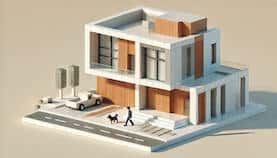Choosing between a fixed-rate and a variable-rate mortgage is one of the most important decisions you will make as a Canadian homeowner.
Your mortgage is likely to be your largest financial commitment, potentially spanning decades. The type of mortgage you choose will influence your financial stability, savings, and even how stressed you are about household finances. With interest rates expected to slowly decline over the next two to three years, understanding the best option can save you thousands of dollars.
In this article, we will explore fixed- and variable-rate mortgages in detail, examining how they work and what to consider when deciding on one. Each has its advantages and disadvantages, but these can change according to conditions in the broader Canadian economy. By the end, you will be equipped to make an informed decision that aligns with your financial goals and risk tolerance, whether you are a first-time homebuyer or looking to refinance.
Fixed Vs. Variable Rate Mortgages: Overview
Fixed-Rate |
Variable-Rate |
|
|---|---|---|
| PROs |
|
|
| CONs |
|
|
What is a Fixed-Rate Mortgage?
A fixed-rate mortgage is exactly what it sounds like – a mortgage where the interest rate remains constant throughout your term length. Your term is usually a five-year period in which you have specified mortgage conditions. However, you can have various term lengths in Canada, ranging from six months to ten years.
With a fixed-rate mortgage, your monthly payments stay the same throughout the term, along with the portion of each payment directed to principal and interest. You’ll have a clear prediction of your outstanding mortgage balance after finishing your mortgage term.
How Fixed-Rate Mortgages Work
When you secure a fixed-rate mortgage, you lock in an interest rate for a specific term, typically ranging from six months to ten years in Canada.
At the end of your term, your fixed-rate mortgage doesn’t automatically renew at the same rate. Instead, you can shop around at the current market rates. While your existing lender may offer a renewal rate, it’s best to negotiate and compare with a mortgage platform like Everyrate.
Pros of Fixed-Rate Mortgages
- Predictability and stability: Your mortgage interest rate and payments remain consistent throughout the term, making budgeting easier.
- Protection from rate increases: If market interest rates rise, your rate stays the same, shielding you from higher costs.
- Peace of mind: You don't need to worry about market fluctuations affecting your mortgage payments.
- Predictable amortization schedule: As long as you make all your payments during the term, you will know your outstanding loan amount at renewal.
Cons of Fixed-Rate Mortgages
- Missing out on potential savings: If interest rates fall during your term, you won't benefit unless you refinance or wait for renewal.
- Higher penalties for breaking the mortgage: Fixed-rate mortgages typically have higher prepayment penalties (Interest Rate Differential or 3 months interest, whichever is greater) compared to variable-rate mortgages.
- Less flexibility: You may miss out on the opportunity to take advantage of falling interest rates without refinancing or waiting for renewal.
What is a Variable-Rate Mortgage?
Variable-rate mortgages are tied to your lender's prime rate, which is influenced by the Bank of Canada’s rate. A misconception is that your monthly payments change with the interest rate. While this can happen in Canada, it’s more common for variable-rate mortgages to have fixed monthly payments.
When interest rates change, so does the portion of each payment going toward interest and principal. Decreasing rates mean more of your payment goes to the principal while increasing rates mean more goes to interest.
How Variable-Rate Mortgages Work
With a variable-rate mortgage, your interest rate is expressed as the prime rate plus or minus a certain percentage. For example, if your mortgage is prime minus 0.5%, and the prime rate is 5%, your mortgage rate would be 4.5%.
If the prime rate changes, your mortgage rate is adjusted accordingly. The variable rate is expressed as P ± X, where P is the prime rate, and X is the adjustment factor. X can vary based on your credit score, the lender's policies, and market conditions.
When your mortgage term ends, the impact of any rate changes becomes apparent. If rates have increased, more of each payment has gone towards interest rather than principal. You may be behind on paying off the principal within your original amortization schedule.
To stay on track with the original amortization, your next set of payments must be higher. Alternatively, you might need to refinance and extend the amortization period to keep your payments at a manageable level.
If rates have decreased, more of each payment has gone towards principal rather than interest. Congratulations! You're likely ahead on your amortization schedule. This puts you in a favourable position for your next term, potentially allowing for lower payments or a shorter amortization period.
Pros of Variable-Rate Mortgages
- Potential for greater savings: Historically, variable rates have proven to be less expensive over time compared to fixed rates.
- Lower penalties for breaking the mortgage: Variable-rate mortgages typically have lower penalties (three months of interest) for breaking or switching compared to fixed-rate mortgages.
- Ability to take advantage of falling rates: If market rates decrease, you'll benefit from lower interest costs without having to refinance.
- Flexibility to switch: Many lenders allow variable-rate mortgage holders to switch and lock in a fixed rate at any point during their term.
Cons of Variable-Rate Mortgages
- Interest rate uncertainty: Your interest rate can change during the term, potentially affecting your monthly budget and the amount of interest you pay.
- Risk of payment increases: If rates rise significantly, your mortgage payments may increase, potentially straining your budget.
- Stress factor: Some borrowers find the unpredictability of variable rates stressful, especially in volatile economic conditions.
- Potential impact on amortization: If rates rise and stay high, you might pay more interest and less principal, which can extend your amortization period.
- Qualification challenges: Borrowers must qualify at a higher stress test rate, which can make it harder to get approved for a variable-rate mortgage.
Key Differences Between Fixed and Variable Mortgages
The primary difference between these two mortgage types lies in how they respond to changes in interest rates set by the Bank of Canada.
- Interest rate stability: Fixed-rate mortgages maintain the same interest rate throughout the term, while variable rates fluctuate with the lender's prime rate.
- Payment structure: Fixed-rate mortgage payments remain constant. Variable-rate mortgage payments also typically stay the same, but the proportion going towards principal versus interest changes with interest rates.
- Initial rates: Variable-rate mortgages often start lower than fixed-rate mortgages, potentially offering more savings initially.
- Market responsiveness: Variable rates can benefit from falling interest rates without refinancing, while fixed rates protect against rising rates.
- Prepayment penalties: Breaking a fixed-rate mortgage typically incurs higher penalties (Interest Rate Differential or 3 months' interest, whichever is greater) than variable-rate mortgages (usually 3 months' interest).
Factors to Consider When Choosing
Choosing between a fixed and variable-rate mortgage isn't a black-and-white process. Regardless of your financial situation, here are some crucial factors to consider:
- Risk tolerance: Are you comfortable with the possibility of your mortgage interest payments going up, or do you prefer the peace of mind that comes with fixed payments?
- Economic forecasts: What's the outlook for interest rates? If rates are expected to decline slowly over the next two years, this could influence your decision to go with a variable rate.
- Length of mortgage term: How long are you planning to stay in your house, and what term of mortgage are you looking to sign? You can always change it when it comes up for renewal.
Case Studies and Examples
To illustrate how these different mortgage types play out, let's consider two hypothetical Canadian homeowners:
Case Study 1: Sarah - Fixed-Rate Mortgage
Sarah, a risk-averse first-time homebuyer, chose a 5-year fixed-rate mortgage at 3.5% in 2020 for her $400,000 home purchase. Over the next two years, interest rates rose significantly, with the Bank of Canada's overnight rate increasing from 0.25% to 5% by mid-2023. Her mortgage payment is $2,000 per month.
While Sarah's colleagues with variable-rate mortgages saw the interest portion of their monthly payments increase dramatically, Sarah’s remained fixed at $914.68. This means the remainder of her monthly payment, $1,085.32 (=2,000-914.68), remains directed towards paying off her loan principal. As such, arah paid down more of her mortgage principal during this term and saved on additional interest owed.
Case Study 2: Mike - Variable-Rate Mortgage
Mike opted for a variable-rate mortgage at the prime rate minus 0.5% in 2020 for his $400,000 home purchase, starting at 2.45%. Initially, Mike benefited from a lower rate than the 3.5% fixed rates available at the time. His starting monthly payment was $1,775.
However, when interest rates rose sharply in 2022-2023, Mike's interest rate increased to 6.7% (prime at 7.2% minus his 0.5% discount). While his monthly payments remained the same, he’s now paying more interest per monthly payment. Less of every monthly payment went towards paying down his mortgage's principal. At the end of his term, Mike will have paid off less principal and must make additional payments or refinance his mortgage to maintain his amortization schedule.
Expert Opinions and Recommendations
There are differing opinions on whether a fixed or variable-rate mortgage is best, but most financial advisors agree it depends on a borrower's circumstances. Here are some expert insights to consider when making your own decision:
- 1. Bank of Canada Governor Tiff Macklem warns that interest rates are unlikely to return to pre-pandemic lows and will decrease gradually as inflation approaches the central bank's target over the next year.
- 2. Eitan Pinsky, a Vancouver mortgage expert, suggests that for variable-rate mortgages to be cheaper than fixed rates, the Bank of Canada would need to lower its policy rate by about two percentage points over the next three years. Currently, variable rates range from around 6% to 6.5%, depending on the lender (Lord, 2024).
- 3. James Laird, co-CEO of Ratehub.ca, says the risk of further rate hikes is never zero. Canadians banking on cuts should keep an emergency fund in case their monthly payments stay high throughout their mortgage term.
Additional Considerations
Choosing between a fixed rate and a variable rate isn't the end of the process. Regardless of your decision, here are some other important factors to consider.
Hybrid Mortgages
Some lenders offer hybrid mortgages, which combine fixed and variable rates. For example, you might have 50% of your mortgage at a fixed rate and 50% at a variable rate. This can be a way to hedge your bets and get the best of both worlds.
Rate Caps and Floors
Some variable-rate mortgages come with rate caps, which limit how high your rate can go. This can provide some protection against dramatic rate increases. Conversely, rate floors set a minimum rate, protecting the lender if rates fall very low.
Prepayment Options and Penalties
Both fixed and variable-rate mortgages can come with prepayment privileges, allowing you to pay extra on your mortgage without penalty. However, if you need to break your mortgage entirely (for instance, if you're selling your home), the penalties can vary significantly:
- Fixed-rate mortgages typically have higher prepayment penalties, often based on the greater of three months' interest or the interest rate differential (IRD) which is the difference between your mortgage rate and the lender's posted rate for a similar term at prepayment minus any rate discounts.
- Variable-rate mortgages usually have lower penalties, typically three months' interest.
Always review the prepayment terms carefully when choosing a mortgage, as these can significantly impact your flexibility and your potential savings. While open mortgages offer penalty-free prepayments at the cost of higher interest rates, most closed mortgages still allow substantial prepayments.
Typically, closed mortgages permit prepayments of around 20% of the principal per year, balancing lower rates and prepayment flexibility.
Mortgage Default Insurance
If your down payment is less than 20% of the home's purchase price, you're required to purchase mortgage default insurance. This protects your lender and adds an additional expense to your monthly payment.
Convertibility
Some variable-rate mortgages in Canada allow you to convert to a fixed rate during the term without incurring a penalty. This can provide you with some flexibility if you're concerned about rate increases.
First-Time Home Buyer Incentives
Canada offers first-time homebuyers like the First-Time Home Buyer Incentive (FTHBI) and the Home Buyers' Plan (HBP), which can affect your mortgage calculations and decision-making process and offer significant savings.
Renewal Process
If you haven't paid off your mortgage by the end of your term, you'll need to renew it. This is an opportunity to reassess your mortgage type between fixed and variable, choose the term length, and compare rates.
Conclusion
Choosing between a fixed and variable-rate mortgage depends on your financial situation, risk tolerance, and economic conditions. Fixed-rate mortgages offer stability with predictable interest payments, while variable-rate mortgages offer flexibility and potential savings.
With interest rates expected to decline slowly in 2024-2025, some may be tempted by variable rates. However, ensure you can afford payments if rates rise and keep long-term goals in mind. Use tools like Everyrate.ca to compare options and consult a mortgage professional for personalized advice. There's no one-size-fits-all choice; select the mortgage that best aligns with your financial situation and goals.
Mortgage Rates in Vancouver | Mortgage Rates in Victoria| Mortgage Rates in BC| Mortgage Rates in Ontario








